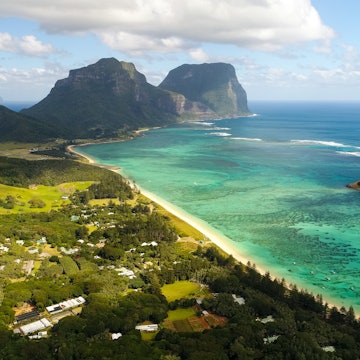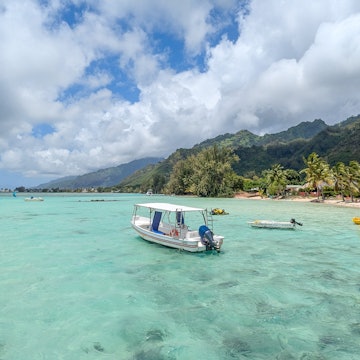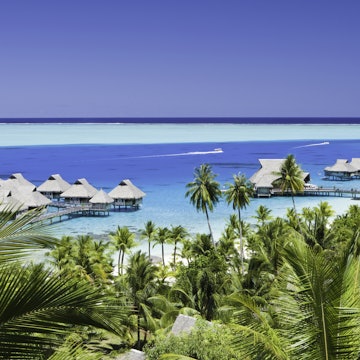
How to visit Tahiti and French Polynesia on a budget



Bike and e-bike rentals mean you can explore on two wheels, saving money and avoiding tour groups at the same time. Maridav/Shutterstock
No, there's no need to remortgage the house to visit Tahiti and French Polynesia. Despite a reputation for opulence and exclusivity, it's perfectly possible to visit these dreamy South Pacific islands on a limited budget – if you make the right decisions. Check out these tips to plan your trip to the islands without breaking the bank.
Daily costs
Hostel room: 3000–5000 CFP (US$30-50)
Basic room for two: 5000-8000 CFP (US$50-80)
Basic self-catering apartment (including Airbnb): 10,000-35,000 CFP (US$100-350)
Overwater bungalow: 90,000-200 000+ CFP (US$900-2000+)
Public transport ticket: 200-600 CFP (US$2-5)
Local style baguette sandwich: 300-600 CFP (US$3-6)
Dinner for two at a food truck: 4000 CFP (US$40)
Plan your flights in advance
Book your flights to Pape’ete early with budget airlines, and keep an eye out for special offers and discounts. FrenchBee and United often have great deals from the USA. Travellers from Australia or New Zealand, should check Air NewZealand or Air Calin for the best fares.
When in the country, there are two local airlines that fly between Tahiti and other islands. The new kid on the block, Air Moana, offers cheaper airfares than rival Air Tahiti, though it services fewer destinations. If you’re looking to visit multiple islands, it's worth checking out Air Tahiti’s special multi-islands passes, with discounts on domestic flights to two or more islands. Note also that flight prices increase every school holiday and during the high season (between May and October).

Is there affordable accommodation?
Glossy brochures focus on ultra-swish resorts but French Polynesia actually has a pretty wide range of accommodation options. You can keep lodging costs down by staying in pensions (small local guesthouses) that are sprinkled around the islands. (To book, visit tahititourisme.com for a list of accommodation options and contact details.) They're nothing glam or ostentatious, just modest operations that blend perfectly into the tropical surroundings.
At the cheaper end of the scale (around US$100 a double), they consist of simple, local-style bungalows with cold showers and thin walls. Upmarket versions (plan on US$150 to US$250) have lots of amenities and are more comfortable.
These options are generally excellent value, and they offer good opportunities for cultural immersion; they're mostly family-run operations (which ensures your money goes straight into local pockets) and provide much more personal, idiosyncratic experiences than hotels – the perfect island experience.
Many pensions are in scenic locations, tucked away in greenery-cloaked hills or near the ocean. In the Tuamotu archipelago, they feature a fab lagoon frontage – at US$100 a double, how does a bungalow facing the turquoise waters of the lagoon sound?
Good news, too, for those who want to spend their holiday under canvas: French Polynesia has a smattering of camping options around. Don't expect full-blown camp sites, though; generally it's a matter of guesthouses having areas where you can pitch your tent and allowing use of the facilities. The price? Around US$20 per person. (Visit tahititourism.com and search “camping” to see what’s available.)

How to get deals on overwater bungalows
Overwater bungalows will never be cheap, but that doesn’t mean there aren’t deals to be had if you book in advance - the earlier, the better. It’s not unusual for people to book their bungalows a year or more in advance to secure their spot and the price. Travelling during the wet season (November to April), especially between January and March, is another way to ensure a lower price point - but it comes with more rain and higher temperatures.
Many resorts offer longer stay discounts for bookings of more than three nights, as well as member discounts, for those who sign up to programs offered by hotel chains (this is usually free).
Another option to consider is booking through a travel agency, as agencies often have access to better deals on this kind of accommodation for their customers. And one final tip: prices on overwater bungalows can change depending on their location or view. For example, a hotel might list a bungalow as having a view of Bora Bora island or of the lagoon. Better views equal higher prices, with lagoon views being the most coveted and expensive.
Choose the best-value islands
As much as Paris doesn't represent France, Bora Bora, Tahiti and Mo’orea (the beloved islands of tour operators), don't sum up French Polynesia. There are about 30 islands (scattered in five archipelagoes) that have tourist facilities, which means that you've got plenty of choice.
Consider lesser-known, off-the-radar islands, which offer greater value for money. A few suggestions: Raiatea, Tahaa (in the Society islands), Mataiva, Tikehau (in the Tuamotus), Nuku Hiva, Ua Huka, Ua Pou (in the Marquesas), Raivavae, and Rurutu (in the Australs).

How to eat cheaply
It's possible to eat reasonably cheaply by patronising snack stands and food trucks (roulottes) and getting takeaway meals like sandwiches, salads, grilled fish and meat or fish burgers. Most pensions offer half-board (bed, breakfast and one other meal) at around US$30 to US$40 per person (set menu). You can usually pay half-board at the outset, or a day or two in advance. This is a fantastic way to meet locals and sample the local cuisine at economical prices.
Self-catering can also save you a lot of money; many pensions have well-equipped kitchens. Eating like a local is your best bet for eating cheaply. There’s a boulangerie on just about every island and a freshly baked baguette will set you back just US$0.60. A baguette with butter and a hot drink like coffee or hot chocolate is a classic, cheap Tahitian breakfast. Fresh fish, fruits and vegetables are easily found at roadside stalls found on most major islands.

Budget-friendly ways to get around
Hiring a car is expensive but it's possible to get around by bike on many islands; distances are rarely great, the traffic is rarely heavy and the roads are rarely hilly. Bikes can be rented for less than US$20 per day. E-bikes are becoming more and more popular in all the islands and can also be rented on a daily basis at around US$60 in more heavily touristed islands.
Public transport is a great budget friendly option in Tahiti. There are frequent buses to and from Pape’ete during peak hours (around 6am-8am and 3pm to 6pm on weekdays). Outside of these hours, buses can be unreliable. The cheapest way to travel by bus is to buy a prepaid bus card, available at the main bus terminal in Pape’ete, which gives you 25% cheaper fares on all routes. Otherwise, it’s best to have cash at hand for the bus. Other islands such as Mo’orea also have bus routes, but these can be unreliable. If in doubt, ask locals when the next bus comes and be prepared to wait.
If you're looking for adventure and have plenty of time on your hands, boat travel is best for inter-island travel. There are frequent local ferry services between Tahiti and other Society Islands – the archipelago that includes Bora Bora and Mo’orea. Local ferry companies include Vaeara’i, Aremiti and Apetahi express, and the ferry terminal is located in Pape’ete.
Cargo vessels serve most islands on a regular basis, especially within the Society group and the Tuamotus. It’s definitely a cheap and unique way to travel between the islands but it’s not for the faint hearted. Take it from someone who’s done it before: travel is slow and rough, and not designed for passenger comfort. Spots on the vessels are often hard to get as they’ll go to locals first, so you need to be flexible and persistent to get on.

Picking the right season
It helps to travel off-season: prices are generally discounted and there's more chance of being able to bargain. Flights are full to bursting in July and August and prices skyrocket accordingly. The Christmas to New Year period is also particularly busy. The best deals can often be found during the shoulder seasons – April to June and September to November.













